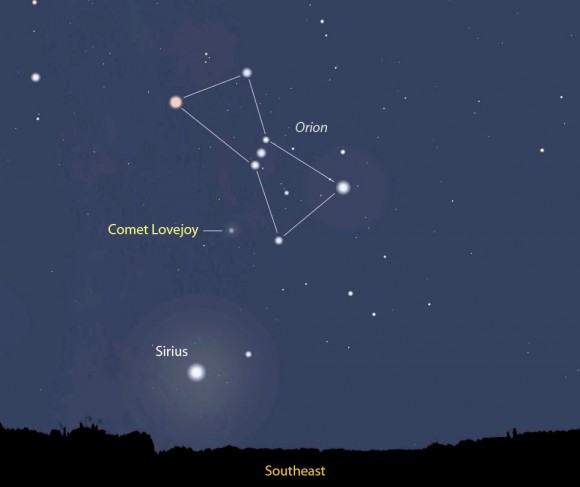Stargazers are in for a treat over the next two weeks while the Lovejoy comet makes its closest approach to Earth.

The glowing green comet is crossing the night sky before disappearing off for 8,000 years!
On a clear dark night, the comet can be seen as a small smudge of light with the naked eye.
Through a small telescope or binoculars it appears as a softly glowing, bluish green ball.
Like other comets, Lovejoy is big chunk of ice and dust orbiting the sun.
The last time it passed through the inner solar system was 11,500 years ago.
From CBBC newsround
Currently passing through the boundaries of Eridanus is a celestial interloper, Comet Lovejoy.
The comet, discovered last August by Australian amateur astronomer Terry Lovejoy (his fifth comet to date), is putting on a show for those equipped with little more than good binoculars or a small telescope. Officially catalogued as C/2014 Q2, this object is now reaching the pinnacle of its brightness; it will be making its closest approach to Earth tonight (Jan. 7) at a distance of 43.6 million miles (70.2 million km).
Until now, the bright early winter moon has been a real nuisance, lighting up the sky and hindering comet observations. Nonetheless, the comet has held its own in the moonlight. On Jan. 3, Lovejoy was shining at magnitude 4.6, a bit brighter than Eta Ursae Minoris, the faintest of the four stars in the bowl of the Little Dipper. [Amazing Photos of Comet Lovejoy]


As such, the comet is now dimly visible to the unaided eye. The coma, or head of the comet, appears 18 arc minutes wide, or three-fifths the apparent diameter of the moon, corresponding to 238,600 miles (383,900 km).
Alan MacRobert, senior editor of Sky & Telescope magazine, says that before the bright moon became too objectionable, his 10x50 binocularsrevealed Lovejoy to be a "biggish puffball, moderately concentrated toward its center." He was also able to perceive the comet's greenish tint. "And this was through moderate suburban light pollution."
From Space.com-http://www.space.com/28196-comet-lovejoy-visible-eridanus-constellation.html

No comments :
Post a Comment
comentários